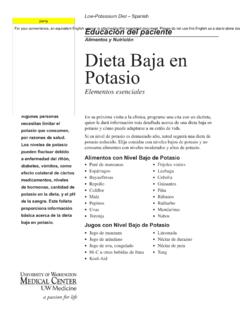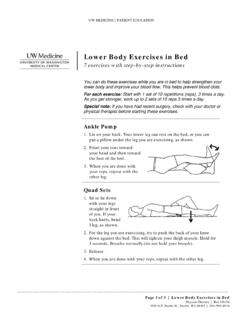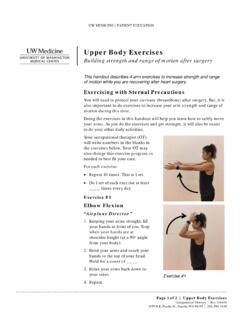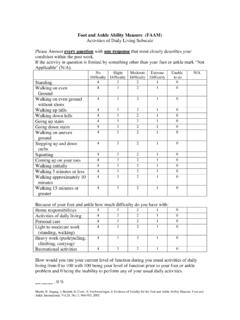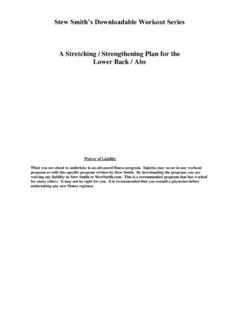Transcription of keep you safe after heart surgery. It includes steps to ...
1 UW MEDICINE | PATIENT EDUCATION _____ Page 1 of 6 | Activities of Daily Living after heart Surgery Occupational Therapy | Box 356154 1959 Pacific St., Seattle, WA 98195 | DRAFT This handout gives important guidelines to follow to help your healing and keep you safe after heart surgery. It includes steps to follow when doing activities of daily living (ADLs) such as getting out of bed, standing up from a sitting position, putting on clothes, taking a shower, and more. Sternal Precautions You will need to protect your sternum (breastbone) after surgery.
2 Most patients must follow sternal precautions for 4 to 12 weeks after having heart surgery. Follow these precautions until your care team tells you otherwise: Do not lift, push , or pull anything that weighs more than 10 pounds. (A gallon of milk weighs almost 9 pounds.) Do not put any of your body weight on your arms. This means you cannot use your arms to lean on or prop yourself up when you are lying down. Do not raise your elbow higher than your shoulders, unless you use both arms together and raise them only in front of your face. Always be aware of the position of your elbows when using your arms.
3 Do not reach behind your back or twist your body. When doing your activities of daily living (ADLs), follow the steps shown on the pages that follow. Activities of Daily Living after heart Surgery Self-care for safety and healing | | | | after heart surgery, you will need to be very careful about how you use your arms. _____ Page 2 of 6 | Activities of Daily Living after heart Surgery Occupational Therapy | Box 356154 1959 Pacific St., Seattle, WA 98195 | DRAFT Getting Out of Bed See photos above. 1. Hug a pillow or cross your arms over your chest. Bend your knees and roll onto your side.
4 2. Move your feet off the bed. Pull your feet against the edge of the bed. Gently use the side of your arm to raise your body to sit up. 3. Sit on the side of the bed before you stand. Getting into Bed 1. Hug a pillow or cross your arms over your chest. Sit near the top third of the bed, as far back from the edge as you can. 2. In one smooth motion, lie on your side and lift your legs up onto the bed. Keep your knees bent. 3. Use your legs to help you roll onto your back. Do not use your arms. You can push with your feet to scoot up or down in bed. Standing Up from a Bed, Chair, or Toilet 1.
5 Hug a pillow or cross your arms over your chest. 2. Lean forward with your nose over your toes. Use your legs to stand. 3. Do not push with your arms. If it is hard for you to stand up from sitting, your OT may suggest you use a higher bed, a pillow or foam cushion in your chair, or a raised toilet seat. _____ Page 3 of 6 | Activities of Daily Living after heart Surgery Occupational Therapy | Box 356154 1959 Pacific St., Seattle, WA 98195 | DRAFT Putting on Shirts Over Your Head See photos above. 1. Lay the front of the shirt in your lap with the collar at your knees.
6 2. Starting from the bottom of the shirt, slide your arms into the sleeves. push the sleeves up past your elbows. 3. Gather up the body of the shirt with your hands. Tuck your chin toward your chest. With both elbows rising in front of your face, place the shirt over your head. 4. Adjust the shirt from the shoulders. Reach across your belly or from the sides as needed. Taking off Shirts Over Your Head See photos above. 1. Reach to the back of your collar with both hands. Pull the shirt over your head. 2. When you remove the sleeves, do not let your elbows move behind your back.
7 _____ Page 4 of 6 | Activities of Daily Living after heart Surgery Occupational Therapy | Box 356154 1959 Pacific St., Seattle, WA 98195 | DRAFT Putting on Pants and Underwear See photos above. 1. Start seated. Reach forward and place your legs into the pants as you normally would. 2. Stand and pull your pants up with your elbows out to the side. 3. Hook your fingers into the waistband. Wiggle your hips and lean forward to pull the pants up into place. If it is hard for you to put on your pants and underwear, your OT may advise you to use a long-handled reacher or a dressing stick.
8 Putting on Socks and Shoes 1. Start seated. Lift one leg and place your ankle onto the opposite knee or place your foot on a foot stool or edge of bed for support. 2. Reach forward and slip on your sock or shoe as you normally would. Repeat with other leg. 3. To remove your socks or shoes, use the same method or briefly bend over from a sitting position. If it is hard for you to put on your socks and shoes, your OT may advise you to use a sock aid, reacher, and long-handled shoehorn. Personal Hygiene after using the toilet, clean by reaching through your legs and wiping front to back. Do not reach behind your back.
9 If this is hard to do, your OT may advise you to use a toilet aid. _____ Page 5 of 6 | Activities of Daily Living after heart Surgery Occupational Therapy | Box 356154 1959 Pacific St., Seattle, WA 98195 | DRAFT Bathing See photos above. For 6 weeks: Do not take a bath. Follow these steps to shower: 1. To wash your incision, gently massage soap on the area with your fingers or a washcloth. Do not scrub your skin or wound. 2. Wash your underarms and the side of your body by lifting your arm only to shoulder-level and reaching across your body. Wash between your legs by reaching front to back.
10 3. Shampoo, rinse, and dry your hair by reaching both hands to your head at the same time. Keep your elbows in front of your face. 4. Sit to dry your body. To reach your back, flip a towel over the top of your head or put on a terrycloth robe. If showering is hard or tiring for you, your OT may advise you to use a shower chair, a hand-held shower head, a non-skid mat, or a bendable long-handled sponge. Hair Care To comb, style, or shave your hair: Raise your arm only to shoulder level, or use both arms with your elbows raised in front of you. _____ University of Washington Medical Center Published PFES: 2007, 2012, 2016, 2017, 2017, 2020 Clinician Review: 10/2017 Reprints on Health Online: Page 6 of 6 | Activities of Daily Living after heart Surgery Occupational Therapy | Box 356154 1959 Pacific St.





